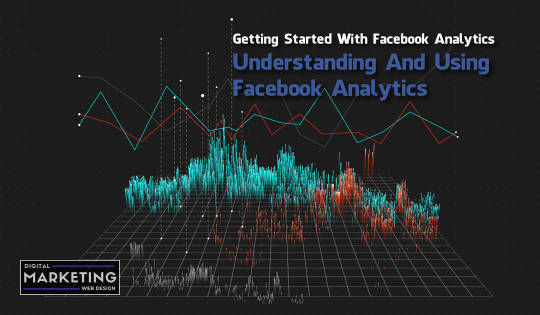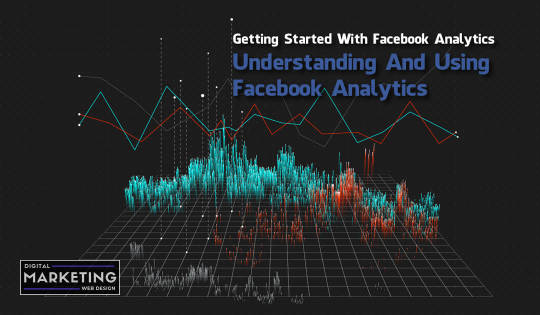#Facebook Analytics
Text
Use Facebook Analytics to Grow your Business | Kartapult
Facebook analytics is used to track the brand's performance. Data provides insights on audience details, page performance and content effectivenes.
#kartapult#automation tool#marketing automation#performance marketing tool#Facebook ads#e-commerce ads#facebook analytics
0 notes
Photo

Getting Started With Facebook Analytics - Understanding And Using Facebook Analytics Facebook advertising and marketing is one of the most effective ways for businesses to reach their target audience. While many small and local businesses are seeing great results from their Facebook... https://digitalmarketingwebdesign.com/getting-started-with-facebook-analytics-understanding-and-using-facebook-analytics/
0 notes
Text
I will setup facebook pixel google analytics 4 migration conversion API with GTM
Do you plan for Facebook pixel setup, conversion API, product catalogs, enhanced e-commerce tracking, or UTM? Google Tag Manager and Google Analytics 4. Ready to boost your business?
What is Facebook Pixel, UTM, Google Analytics 4, and GTM?.
The Facebook Pixel, UTM, Google Analytics, and tag manager are codes that are placed on your website, page, business page, and service related website. It collects and gathers data that converts your ads, optimizes ads, and builds targeted traffic and strong demographics for future ads.
What will I give for your business, service, and targeted audience?
Setup Facebook pixel.
Setup conversion API With GTM.
Conversion API Setup and integration.
Automatic shop catalog and optimization.

#facebookpixelsetup#facebookads#facebook#gtm#google analytics#conversion api#facebook marketing#facebook pages
12 notes
·
View notes
Text

Hiiiiiiiiiiiiii !
#digital marketing#twitter marketing#marketing#seo#instagram marketing#facebook marketing#google ads#google analytics#linkedin marketing#youtube marketing#tumblr marketing#quora marketing#wordpress website#reddit marketing
8 notes
·
View notes
Text
Stop Wasting Time on Social Media Content? Think Again: Why It’s Your Key to Marketing Success

In today’s digital age, small businesses face a daunting challenge: making their social media content heard above the overwhelming noise. Just look at the staggering amount of content published on each platform daily:
TikTok – 23 million
YouTube – 216 million
Facebook – 350 million
X (formerly Twitter) – 500 million
LinkedIn – 2 million
Instagram – 95 million
With millions of pieces of content flooding these platforms every day, it’s no wonder that a significant portion of social media posts go unnoticed, with 59.41% receiving zero engagement. This statistic paints a grim picture for content creators, suggesting that most of their efforts might be in vain, drowned in a sea of digital content.
However, this doesn’t mean small businesses should abandon ship and stop creating social media content altogether. On the contrary, social media remains an invaluable channel for marketing a company, product, service, or personal brand. The key lies not in abandoning the platform but in adjusting the strategy to stand out in the crowded digital marketplace.
The Strategy Shift: From Imitation to Innovation
Emulating popular posts has proven to be less effective than one might hope. Instead, small businesses need to focus on offering something new and fresh that hasn’t been seen before. This approach requires innovation, courage, and authenticity.
Innovate with Unique Content: Your content should offer a new perspective or idea that sets it apart. This uniqueness will capture the audience’s attention like repetitive and derivative content cannot.
Voice Your Opinions: Don’t shy away from expressing your own views. Authenticity resonates with audiences, making your content more memorable and engaging.
Deliver Value: Whether through educational insights, statistics, or data, ensure your audience gains something from your content. Providing value fosters engagement and loyalty.
Trend Wisely: While leveraging trends can be beneficial, it’s crucial to do so only when they align with your industry. This relevance ensures your content resonates with your target audience.
Collaborate for Amplification: Partnering with others in your space, regardless of their follower count, can significantly extend your reach. Collaboration opens doors to new audiences and enhances visibility.
Share Personal Experiences: Content grounded in personal experiences is difficult for others to replicate. It adds a layer of authenticity and relatability that is highly appealing to audiences.
Platform-Specific Content: Understand and cater to the content preferences of each social network. While infographics may have lost their allure, staying attuned to evolving platform trends can optimize your content’s impact.
Beyond Content Creation: The Power of Influence
The effectiveness of your social media strategy extends beyond the content itself. Engaging with influencers and leveraging their reach can exponentially amplify your message. A well-placed tweet or mention from a prominent figure or company in your industry can eclipse the impact of substantial investments in traditional advertising and SEO. This influence-driven approach underscores the importance of networking and building relationships within the digital ecosystem.
In the crowded landscape of social media, the secret to standing out lies not in the volume of your content but in its uniqueness and value. Harness the power of innovation, authentic storytelling, and strategic influencer collaboration to transform your social media efforts into a beacon of engagement and growth for your small business.
#social media#socialmedia#smb#tiktok#analytics#marketing#x#twitter#linkedin#instagram#facebook#youtube
3 notes
·
View notes
Text
Importance of Remarketing
Remarketing offers several advantages that make it an essential component of any digital marketing strategy. First, it allows businesses to target users who have already shown an interest in their products or services, making it more likely that those users will convert.
1. Increased Conversions:
Remarketing targets users who have previously visited your website or interacted with your brand. This can remind them of your products or services, increasing the likelihood of conversions.
2. Improved Brand Recall:
By keeping your brand in front of users through targeted ads, remarketing helps in reinforcing brand awareness and recall.
3. Cost-Effective:
Compared to acquiring new customers, remarketing can be more cost-effective. You're targeting users who already have some familiarity with your brand.
4. Customization and Personalization:
Remarketing allows for highly targeted and personalized campaigns. You can tailor your ads based on the user's previous interactions with your site.
5. Abandoned Cart Recovery:
For e-commerce businesses, remarketing is crucial for recovering abandoned shopping carts. It provides an opportunity to remind users about products they showed interest in but did not purchase.
6. Metrics for Success:
Key metrics for remarketing success include Click-Through Rate (CTR), Conversion Rate, Return on Ad Spend (ROAS), and Cost per Acquisition (CPA).
Sample Remarketing Report Structure:
1. Overview:
Briefly introduce the purpose of the report and provide a snapshot of the remarketing campaign's overall performance.
2. Campaign Performance:
Break down the performance of each remarketing campaign. Include metrics like Impressions, Clicks, CTR, Conversions, and Conversion Rate.
3. Audience Segmentation:
Analyze the performance based on different audience segments. This could include visitors who viewed specific product pages, abandoned carts, or engaged with certain content.
4. Ad Creatives:
Evaluate the effectiveness of different ad creatives. Identify which creatives had the highest CTR and conversion rates.
5. Platform Analysis:
If running remarketing across multiple platforms (Google Ads, Facebook, etc.), compare performance on each platform and allocate budget accordingly.
6. ROI and Cost Analysis:
Calculate the Return on Investment (ROI) for the remarketing campaigns. Analyze the cost-effectiveness of the campaign in terms of acquiring customers.
7. Recommendations:
Provide insights and recommendations for optimizing future remarketing efforts. This could include adjusting audience targeting, refining ad creatives, or reallocating the budget based on performance.

#google ads#google analytics#conversion tracking#remarketing#setup google ads#google tag manager#facebook ads
2 notes
·
View notes
Text

3 notes
·
View notes
Text
Facebook Ads To Get New Buyers-
As facebook is one of the most used social media in the 21th century. So it's a great place to get new buyers. As business must be in place where any businessman can get potential buyers. And facebook can provide a vast amount of potential buyers to any busiess so it's a great place to run your business ads.
Now a days Facebook Ads are a powerful tool for any business to reach new customers and grow your businesses. However, with so many businesses using Facebook Ads, it can be difficult to stand out from the crowd and attract new clients.
I'll Provie Digital marketing service for your business. Connet me today. Here is my facebook page you can check my work here-
facebook.com/hasandigitamedia/

#facebookads#instagrammareting#facebook marketing#digitalmarktagency#digitalmarketing#google ads#google analytics#onlineads#digital marketers#fb marketing#abads#facebook ads#social media marketing#social media advertising
2 notes
·
View notes
Text
Google Ads Campaign Management || Google Analytics & GTM Specialist
It's great to hear about your extensive experience in digital marketing and the wide range of services you offer, including Google Ads, Google Analytics GA4, and Tag Manager services. Your expertise in these areas can be extremely valuable to small business owners and start-ups looking to establish a strong online presence. Here's a summary of your services:
**Google Ads Management Services**:
- Google Ads Campaign Setup
- Advanced Keyword Research
- Google PPC Ads Extension Setup
- Conversion Tracking & Analytics Setup
- Audience Optimization and Budget Setup
- Comprehensive Optimization Strategies
- Campaign Strategy Reports
**Google Analytics 4 & Google Tag Manager Services**:
- Google Analytics (GA4) Setup
- Google Tag Manager (GTM) Setup
- Goals Cross-Domain & Events Tracking
- Form, E-commerce, and Purchase Tracking
- Custom Audience & Remarketing
- Social Ads Conversion Tracking Setup
- Google Ads Conversions Tracking
- Website Interaction Tracking
- Custom Reports and Filters
- Pixel Installation for Remarketing Tags
- Integration with Various Pixels (e.g., Hotjar, Facebook, Twitter, Pinterest, LinkedIn)
**Facebook Services**:
- Facebook Pixel Installation
- Google Tag Manager Setup for Facebook
- Facebook Conversion API Setup
- Server-Side Tracking
- Domain Verification
- iOS 14 Update Compliance
- Shopify Facebook Pixel Tracking
- E-commerce Conversion Tracking
- Aggregated Event Measurement
- GA4 Measurement ID Installation
**GTM Server-Side Tracking Services**:
- Server-Side Tracking for Various Platforms and Pixels
You work with a variety of website platforms, including WordPress WooCommerce, Shopify, Wix, ClickFunnels, Laravel/PHP, and custom websites, making your services adaptable to different clients' needs.
It's also nice to know a bit about your personal life and interests. Your pursuit of a Master's Degree in Digital Marketing demonstrates your commitment to staying up-to-date in the field. And as a cat lover and traveler, you bring a personal touch to your professional profile.
Your comprehensive range of services and your commitment to ongoing education make you a valuable asset in the digital marketing industry. I wish you the best of luck in your endeavors, and I hope your skills continue to benefit your clients and your academic pursuits.
Best Regards!
#digitalmarketingagency #spotify #wordpress #tracking #beauty #portrait #teenage #googleads
#google tag manager#baby animals#facebook ads#facebook pixel#google analytics#google ads#puppies#kittens#kitty#maia arson crimew
2 notes
·
View notes
Text
How to set up Google Analytics 4, Tag Manager, Google Ads Conversion Tracking, and Facebook Pixel

Setting up Google Analytics 4 (GA4), Google Tag Manager (GTM), Google Ads Conversion Tracking, and Facebook Pixel involves several steps. Here's a step-by-step guide on how to set up these tools:
1. Google Analytics 4 (GA4):
Google Analytics 4 is the latest version of Google Analytics. It provides more advanced tracking and reporting capabilities compared to Universal Analytics.
Step 1: Create a Google Analytics 4 Property
Log in to your Google Analytics account.
Click on "Admin" at the bottom left.
In the "Property" column, click "Create Property."
Follow the setup wizard, providing details about your website or app, and choose the data stream type (web or app).
Once the property is created, you'll get a unique Measurement ID (G-XXXXXXXXXX). Make a note of this ID; you'll need it later.
Step 2: Install GA4 Tracking Code
On your website or app, add the GA4 tracking code to each page. You can use Google Tag Manager for this or insert it directly into the code.
If using Tag Manager, create a new tag and select "Google Analytics: GA4 Configuration" as the tag type. Enter your Measurement ID.
Publish the container in Tag Manager to activate the tracking.
2. Google Tag Manager (GTM):
Google Tag Manager allows you to manage various tracking codes and scripts in one place.
Step 1: Create a Google Tag Manager Account
Go to Google Tag Manager.
Sign in with your Google account.
Create an account and container for your website or app.
Step 2: Install GTM Container
Follow the instructions in GTM to install the container code on your website or app.
Publish the container to make it active.
3. Google Ads Conversion Tracking:
Google Ads Conversion Tracking allows you to track conversions from your Google Ads campaigns.
Step 1: Set Up Conversion Actions in Google Ads
Log in to your Google Ads account.
Click on "Tools & Settings" and select "Conversions."
Create a new conversion action and follow the setup wizard. Choose the appropriate type (e.g., website, app, phone calls).
Once created, you'll receive a conversion tracking code.
Step 2: Implement Conversion Tracking Code
Add the Google Ads conversion tracking code to the relevant pages or use Google Tag Manager to deploy it.
If using Tag Manager, create a new tag and select "Google Ads Conversion Tracking" as the tag type. Enter the conversion ID and label.
Publish the container in Tag Manager to activate the tracking.
4. Facebook Pixel:
The Facebook Pixel allows you to track conversions and optimize Facebook ad campaigns.
Step 1: Create a Facebook Business Manager Account
Go to Facebook Business Manager.
Create an account or log in with your existing Facebook account.
Step 2: Create a Facebook Pixel
In Business Manager, click on "Business Settings."
Under "Data Sources," select "Pixels."
Click "Add" to create a new pixel.
Follow the setup instructions and generate your pixel code.
Step 3: Implement Facebook Pixel
Add the Facebook Pixel code to the header of your website or use Google Tag Manager to deploy it.
If using Tag Manager, create a new tag and select "Custom HTML" as the tag type. Paste the Facebook Pixel code.
Publish the container in Tag Manager to activate the pixel.
Once you've completed these steps, you'll have set up Google Analytics 4, Google Tag Manager, Google Ads Conversion Tracking, and Facebook Pixel for your website or app. Make sure to test and verify that tracking is working correctly.
Click To Hire Web Analytics Expert...
#Google_Tag_Manager#Google Analytics 4#GA4#e-commerce tracking#Conversion tracking#Facebook Pixel#Tracking#Gtm#Shopify#Tag Manager#Web analytics#conversion API#analytics#setup#GA4 migration#conversion#CRO#install#optimization#Facebook pixel setup#server-side tracking#set up#online sales#Shopify conversion#e-commerce#website audit#conversion rate#google adwords#google ads#ios 14 update
3 notes
·
View notes
Photo

Getting Started With Facebook Analytics - Understanding And Using Facebook Analytics Facebook advertising and marketing is one of the most effective ways for businesses to reach their target audience. While many small and local businesses are seeing great results from their Facebook... https://digitalmarketingwebdesign.com/getting-started-with-facebook-analytics-understanding-and-using-facebook-analytics/
0 notes
Text
Narayan cake design company and event planner wedding cake birthday cake celebration cake hanging cake chandelier cake anniversary cake many more cake design available please visit my profile contact by Ravi Kumar Bhatnagar 9540 120687










#https://taylaswift.tumblr.com/post/688291702515040256/how-is-it-almost-july-how-are-we-almost-halfway#anniversary cakes#cake#events#wedding cake#digitalmarketing#onlinemarketing#industry#facebook marketing#instagram marketing#youtube marketing#google analytics#seo marketing
17 notes
·
View notes
Text

#Twitter Post Scheduler#Schedule Tweets#Post Scheduler#Instagram Post Scheduler#Social Media Content Calendar#Social Media Analytics Tools#Boosted Social Media#Analytics For Social Media#Social Media Engagement#Social Media Customer Engagement#Increase Engagement On Facebook#Boost Social Media#Social Media Engagement Tool#Social Media Automation Tool
3 notes
·
View notes
Text
Using CrowdFire
Crowdfire is a robust tool for scheduling social media posts. Crowdfire can be used for analytics, mentions, accounts, scheduling, bulk scheduling, and content curation. One of her talents is content curation. This function aids in aggregating content from many sources and preparing it for sharing.
You can choose and schedule your own posts using Crowdfire (these are already published, so they are automatically recognized). Alternately, you can select one of the relevant articles and photos that Crowdfire has carefully selected. Simply enter the topics that interest you, then continue.
For your Instagram account and other popular social media sites, Crowdfire serves as your marketing partner, managing all the key responsibilities of a social media marketer, including analytics, content moderation and management, and publishing.
With Crowdfire, marketers can preview, publish, and schedule posts for Instagram, Twitter, Facebook Pages, LinkedIn, and Pinterest from a single dashboard. Users can track unfollowers, follow connected persons, follow rivals, and keep an eye on followers' dormant accounts thanks to platform administration capabilities.
So click here to use this great tool!
#crowdfire#social media#marketing#analytics#management#publish#instagram#twitter#facebook#linkedin#pinterest
4 notes
·
View notes
Text
Drive Results: Online Facebook Analytics Report Tool
The Drive Results Online Facebook Analytics Report Tool represents a pivotal solution in the ever-evolving landscape of digital marketing. In the era where Facebook has become a cornerstone for businesses seeking to connect with their audiences, understanding the efficacy of one's efforts on the platform is paramount. This tool serves as a comprehensive platform designed to empower businesses with actionable insights derived from Facebook's rich data ecosystem.
Central to the Drive Results tool is its ability to aggregate, analyze, and interpret data from various facets of Facebook marketing efforts. From page insights to ad performance metrics, audience demographics, and engagement statistics, the tool offers a centralized dashboard where businesses can gain holistic visibility into their Facebook presence. By consolidating this wealth of information, businesses are equipped with the intelligence necessary to optimize their strategies and drive tangible results.
Key to the efficacy of the Drive Results tool is its capacity to track and evaluate key performance indicators (KPIs) aligned with each business's unique objectives. Whether the goal is to increase brand awareness, drive website traffic, or generate leads, the platform provides customizable reporting options tailored to monitor the metrics most relevant to achieving these aims. From reach and impressions to click-through rates and conversion metrics, businesses can assess the performance of their Facebook campaigns with precision.
Furthermore, the Drive Results tool offers advanced analytics capabilities that delve beyond surface-level metrics, enabling users to uncover actionable insights and emerging trends. Through data segmentation and comparative analysis, businesses can identify their most valuable audiences, discern content that resonates best, and refine targeting strategies for optimal impact. This granular level of analysis empowers businesses to iterate on their Facebook marketing initiatives iteratively, continuously optimizing performance and driving meaningful outcomes.
An additional strength of the Drive Results tool lies in its intuitive interface and user-friendly design. Recognizing that not all users possess a deep understanding of data analytics, the platform presents complex insights in a visually engaging and accessible format. Interactive charts, graphs, and dashboards provide at-a-glance insights, while customizable reports allow users to delve deeper into specific metrics and trends. Moreover, the platform offers real-time monitoring capabilities, ensuring businesses remain abreast of their Facebook performance at all times.
Beyond its analytical prowess, the Drive Results tool facilitates collaboration and communication among team members. With features such as shared dashboards, automated alerts, and scheduled reports, businesses can streamline workflows and foster cross-functional alignment. Whether it's marketing teams refining campaign strategies or executives monitoring overall performance, the platform serves as a centralized hub for data-driven decision-making.
Looking ahead, the Drive Results Online Facebook Analytics Report Tool is poised to evolve in response to changing market dynamics and emerging trends. With ongoing updates and enhancements, businesses can expect access to even more robust features and capabilities to remain competitive in an increasingly complex digital landscape. Ultimately, by harnessing the power of data and analytics, businesses can maximize their results on Facebook, driving growth, engagement, and success in the digital realm.
#facebook page analytics free#facebook group analytics free#facebook page analytics report#facebook social media report#free facebook analytics report
1 note
·
View note
Text
3 notes
·
View notes